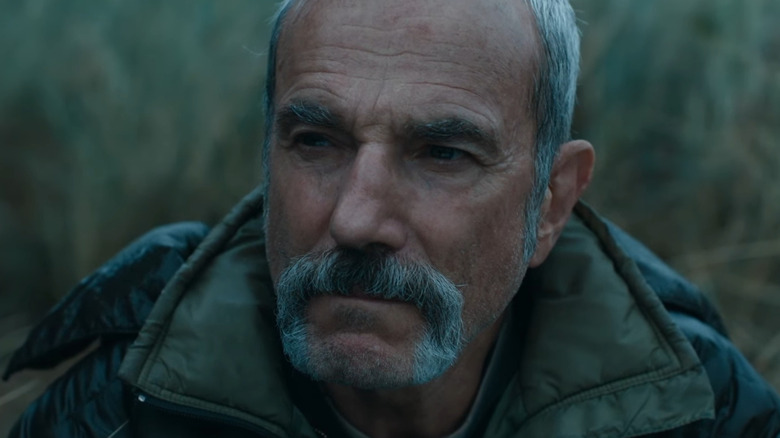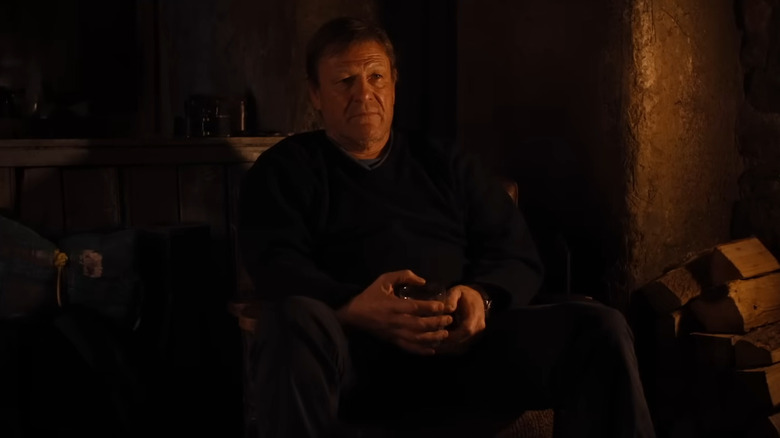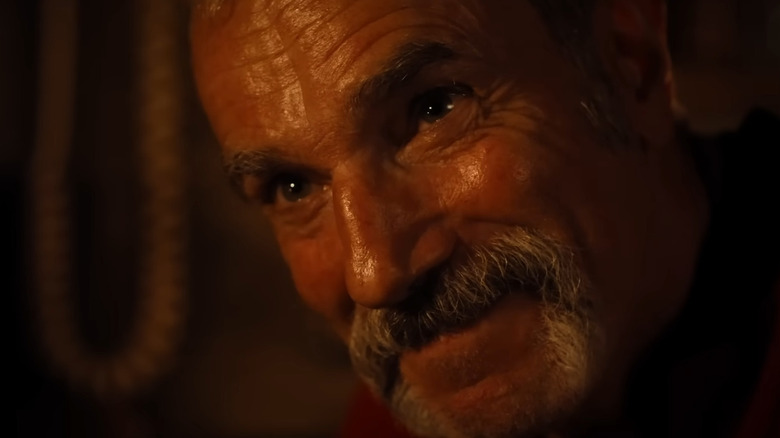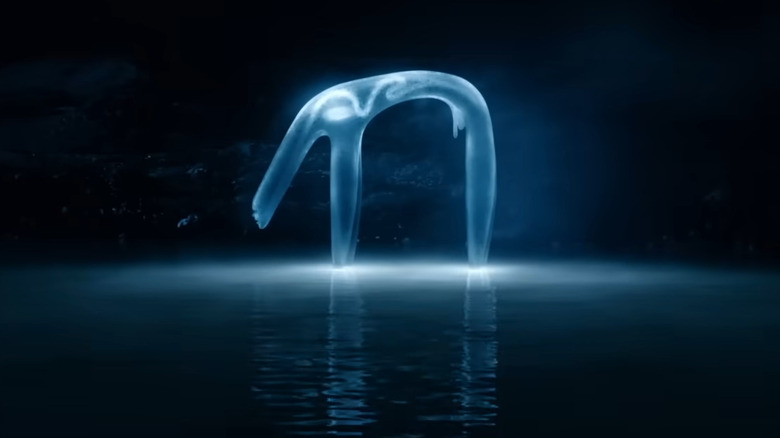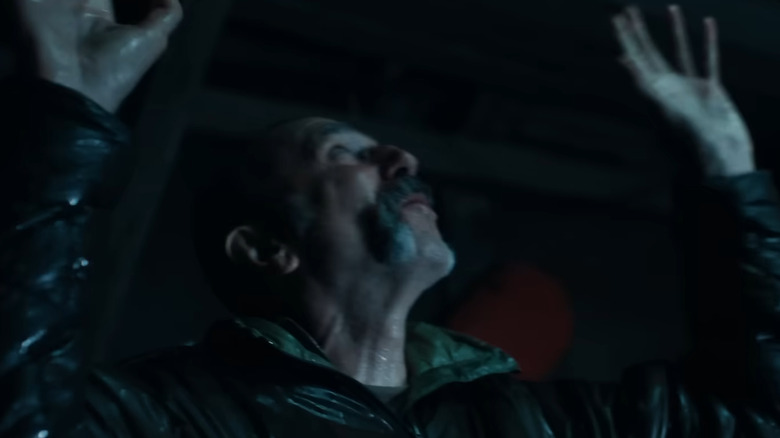Anemone Ending Explained: Internal Shame Is An Overwhelming Force Of Nature
This article contains spoilers for "Anemone."
The buzz surrounding "Anemone" stemmed from the film being Daniel Day-Lewis' formal return to acting since his self-imposed retirement in 2017, with his last feature being Paul Thomas Anderson's "Phantom Thread." By any other measure, getting another performance out of the Academy Award-winning acting thespian is cause for celebration. In addition to starring in "Anemone," Daniel also co-wrote the screenplay with his son Ronan Day-Lewis, who makes his feature directorial debut here. /Film's Jeremy Mathai praises Daniel's performance in his review, in addition to believing that "Anemone" marks a promising first step in the right direction for Ronan as a filmmaker. First-time directors are always saddled with the weight of expectation on their inaugural go-around, as they're often working within the limited resources they have. In Ronan's case, he has a $35 million budget, studio backing, and one of our greatest living actors at the center, and yet "Anemone" plays like an expensive student film.
Experimental in nature, "Anemone" wants to establish itself as a visual treatise on the encompassing melancholy clouding a regretful man, yet it never feels as if it escaped the conceptual stage. Even Daniel, who gives an admirable performance, is sadly left floating in the wind in a film that feels woefully undercooked at best. Its metaphors on the ruminations of the past are anything but abstract, with Bobby Krlic's comically overbearing score neutering any potential nuance. I thrive on slow cinema, but Ronan struggles to evoke an emotional weight through Ben Fordesman's lush cinematography. Woven within the lengthy monologues and sullen silences is ultimately a story about a man filled with shame, and the lengths to which he's bound by it.
Jem Stoker seeks out his self-exiled brother Ray Stoker
Familial relationships are at the forefront of "Anemone," with the most prominent being one of two brothers. Jem Stoker (Sean Bean) is moved by a sense of personal divine purpose and travels out to the Northern English countryside to make amends with his estranged sibling Ray (Daniel Day-Lewis), whom he hasn't seen in over 20 years. The cabin Ray has shacked up in looks like something out of an "Evil Dead" movie, which makes sense considering it's meant to visualize the mossy rot of his exile. In some ways, it mirrors Daniel's isolation from the acting sphere for nearly a decade now. Jem's arrival isn't met with disdain or open arms, so much as apathy. Whether in the cabin, a bar, or out in nature, the pair largely spend most of the movie in silent company, with Jem acting as a present listener. /Film's Bill Bria praises Bean's subdued performance in particular as the secret weapon of "Anemone."
It's revealed over the course of the film that Ray fathered a child named Brian (Samuel Bottomley) with 911 operator Nessa (Samantha Morton), and then left them to live alone in his secluded mossy abode with his own thoughts. Jem felt personally bound to make up for his brother's mistakes by marrying Nessa and being a stepfather to Brian. In spite of stepping up to fill the familial gap, Jem feels compelled to bring his brother back home after so much time has passed because he feels Brian needs his father to guide him during a rough period in his life. It becomes clear that the defensive Ray is harboring a lot of feelings he's kept bottled up for most of his life, as he avoids taking responsibility for abandoning his family. When the quiet hermit does speak, he does so through a series of revealing monologues.
Ray Stoker chronicles his inner turmoil through a series of monologues
Ray breaks the uncomfortable silence with a vulnerable monologue about his reunion with the pedophilic priest who molested him as a young boy. It turns out that Ray lured the pastor to his place many years later, yet wasn't recognized. He later enacted his revenge by seducing him, followed by unleashing a potent cocktail of curry, Guinness, and a whole lot of laxatives all over his face. It shows the extremes Ray is willing to go to resolve his inner conflict rather than, say, going to therapy. Daniel's delivery walks that balance of eliciting empathy and uncomfortable laughter. The most revealing insight into this character, however, arrives towards the end of the film, where he reveals the extent of his emotional turmoil.
Ray, once known as "Invisible Man," had served in the British military amid the Troubles conflict in Northern Ireland. One day, he witnessed an IRA bomb maker and his teenage apprentice accidentally get blown to bits. With the apprentice writhing in pain, Ray puts the kid out of his misery with a gunshot. But since he was alive and unarmed when the killing occurred, it's considered a war crime and led to his dishonorable discharge. Ray claims he doesn't really know why he did it, but it torments him nonetheless. We're shown a lengthy childlike tapestry at the top of the film that depicts bombings, flames, and strewn bodies all over the place. There's a great irony, however, in how "Anemone" visually transcribes the effect of militarized violence on the human soul when these characters hardly feel like they have one.
Ray shares an odd encounter with a water horse abstraction
After Ray bares his shame about his militaristic transgression, he encounters a strange, bright figure near the water. It looks like a horse as if it were drawn by a small child. The closer Ray gets to it, the more it starts to grow extensions like internal organs that move around in its body, a distorted face, and genitals. In an interview with ScreenRant, Ronan talks about how the creature was something that had been swirling around in his mind, and is open to all sorts of interpretations on what it means. I tend to read it as this amalgamation of lost innocence reflected in Ray. He drowns himself in his own sorrows to the point that it's reflected back at him through a watery doodle Brian probably would have drawn as a kid; therefore, he partially sees himself in it as well. Cinematically, it speaks to the larger issue at the center of "Anemone."
Fordesman's cinematography is morose and moody, with an oppressive gloom hanging over the entire film. It's beautiful in the sense that it's not portrayed in a grounded manner, so much as a surrealistic one. The film's many abstractions, such as a gutted mutant fish floating downriver, are glaringly obvious renderings of Ray's internal shame that come across as more tedious than affecting. "Anemone" becomes trapped in a repetitive pattern in which its visuals become tiring and, quite frankly, boring to look at. To make matters worse, Ronan ends his directorial debut with a sequence that feels like such a rookie mistake.
A Biblical hail storm knocks Ray out of his funk
While a troubled Brian sits in his bedroom, a baseball-sized piece of hail lands on his bed. What transpires is a hailstorm of biblical proportions that appears from out of nowhere. Every character stops what they're doing to witness the deadly downpour in shock and horror. Jem and Ray tussle at the same time, which leads the latter to ultimately seek forgiveness and return with Jem. Sadly, the hail storm that prompts Ray to abandon his isolation is possibly the film's worst sequence because it evokes a much better film in the guise of PTA's "Magnolia."
In PTA's film, the frog storm is the only surrealistic flourish in a movie about how there are no coincidences. It's a violent and, more importantly, confusing interruption that knocks every character in its sprawling ensemble out of their funk. The crucial difference between "Anemone" and "Magnolia" is that PTA's storm is a shocking development, while Roman's arrives right on time. It doesn't come as much of a shock, considering the film's abrasive score and gloomy overcast is clearly building to some kind of explosive development. All we're left with at the end of Ronan's film is a quiet moment between Ray and Brian at the doorstep. All that mattered was getting Ray to rejoin his family, and it's left up to them whether he's accepted back or not.
Unfortunately, Ronan is as estranged from his concepts as Ray is from his son. I'm glad something so experimental as "Anemone" is being released by a major studio, even though it's more a matter of having Daniel at the forefront of a meandering and dreadfully dull debut.
"Anemone" is now playing in limited release, with a nationwide rollout on October 10, 2025.
